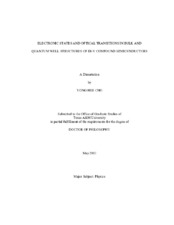| dc.contributor.advisor | Belyanin, Alexey | |
| dc.creator | Cho, Yong Hee 1976- | |
| dc.date.accessioned | 2015-01-09T19:56:23Z | |
| dc.date.available | 2015-01-09T19:56:23Z | |
| dc.date.created | 2011-05 | |
| dc.date.issued | 2011-05-06 | |
| dc.date.submitted | May 2011 | |
| dc.identifier.uri | https://hdl.handle.net/1969.1/152436 | |
| dc.description.abstract | In this work we apply the methods of band structure calculation combined with self-consistent treatment of the light-matter interaction to a variety of problems in bulk semiconductors and semiconductor heterostructures as well as in new optoelectronic devices.
In particular, we utilize the 30- and 8-band k • p band structure calculation methods to study the electronic, magnetic, and optical properties of the diluted magnetic semiconductor, GaMnAs, in the mean-field Zener model. We calculate the anisotropic dielectric response of GaMnAs in the metallic regime and show that our model produces a good agreement with the experimental results of magneto-optical Kerr spectroscopy in the interband transition region. We also discuss the advantages of the 30-band k • p model for spin-polarized ferromagnetic GaMnAs.
We present new methods for calculating electronic states in low-dimensional semiconductor heterostructures based on the real-space Hamiltonian. The formalism provides extreme simplicity of the numerical implementation and superior accuracy of the results. They are applicable to a general n-band k • p model and specifically tested in the 6-, 8-band k • p models, and a simple parabolic one band model. The transparency of the new method allows us to investigate the origin and elimination of spurious solutions in the unified manner. Spurious solutions have long been a major issue in low- dimensional band structure calculations.
As an application of nonlinear optical interactions in two-dimensional semiconductor heterostructures, we calculate the upper limits on the efficiency of the passive terahertz difference frequency generation based on the intersubband resonant nonlinearity. Our approach incorporates electronic states together with propagating coupled fields through the self-consistent calculation of the Poisson equation, density matrix equations, and coupled wave equations. We develop optimal device geometries and systematically study the device performance as a function of various parameters. The results are compared with a simplified analytic solution. | en |
| dc.format.mimetype | application/pdf | |
| dc.subject | conversion efficiency | en |
| dc.subject | Poisson equation | en |
| dc.subject | densty matrix equation | en |
| dc.subject | coupled field equations in lossy media | en |
| dc.subject | difference frequency generation | en |
| dc.subject | terahertz(THz) radiation | en |
| dc.subject | self-consistent calculation | en |
| dc.subject | resonant nonlinearity | en |
| dc.subject | intersubband transition | en |
| dc.subject | 8-band k • p model | en |
| dc.subject | envelope function approximation | en |
| dc.subject | Fourier grid Hamiltonian method | en |
| dc.subject | delta function method | en |
| dc.subject | eigen solutions in semiconductor quantum wells | en |
| dc.subject | semiconductor heterostructure | en |
| dc.subject | low dimensional semiconductor | en |
| dc.subject | interband transition | en |
| dc.subject | Kerr effect | en |
| dc.subject | 30-band k • p model | en |
| dc.subject | GaMnAs | en |
| dc.subject | Diluted magnetic semiconductor | en |
| dc.title | Electronic States and Optical Transitions in Bulk and Quantum Well Structures of III-V Compound Semiconductors | en |
| dc.type | Thesis | en |
| thesis.degree.department | Physics and Astronomy | en |
| thesis.degree.discipline | Physics | en |
| thesis.degree.grantor | Texas A & M University | en |
| thesis.degree.name | Doctor of Philosophy | en |
| thesis.degree.level | Doctoral | en |
| dc.contributor.committeeMember | Eknoyan, Ohannes | |
| dc.contributor.committeeMember | Kocharovskaya, Olga | |
| dc.contributor.committeeMember | Sinova, Jairo | |
| dc.type.material | text | en |
| dc.date.updated | 2015-01-09T19:56:23Z | |


